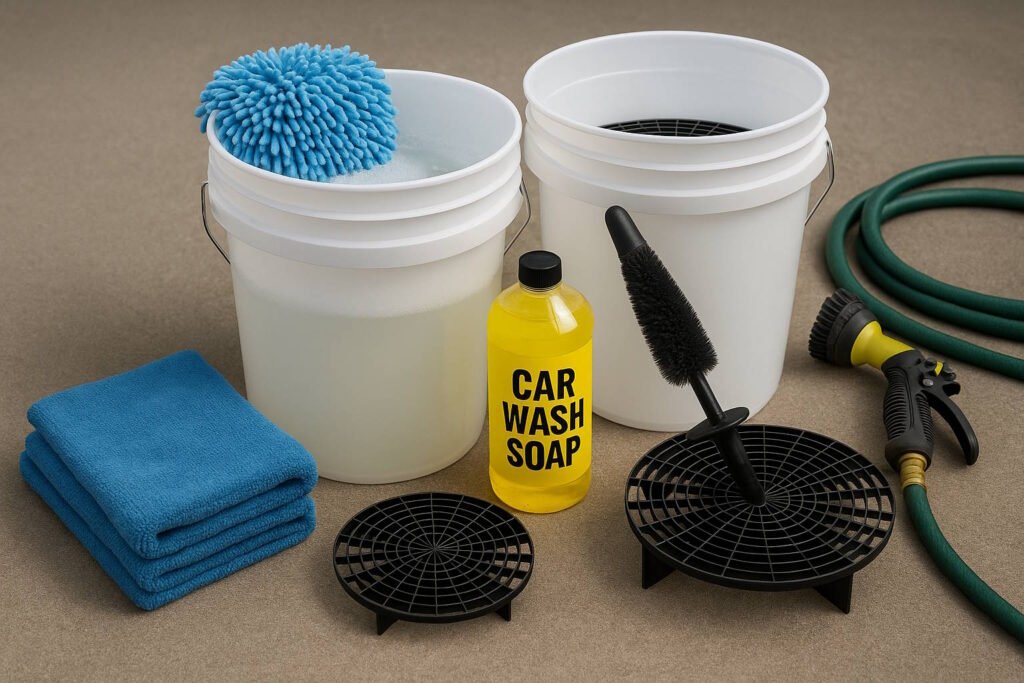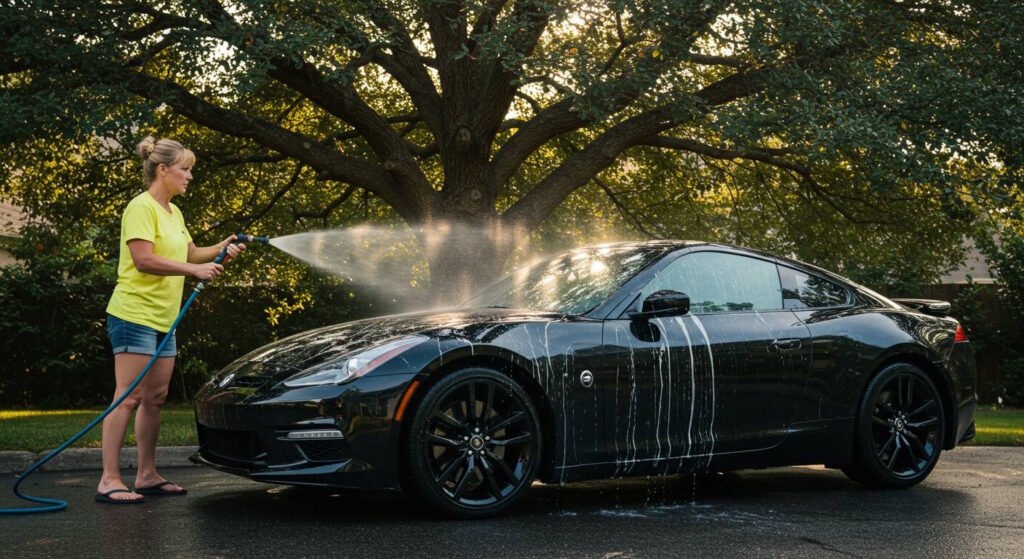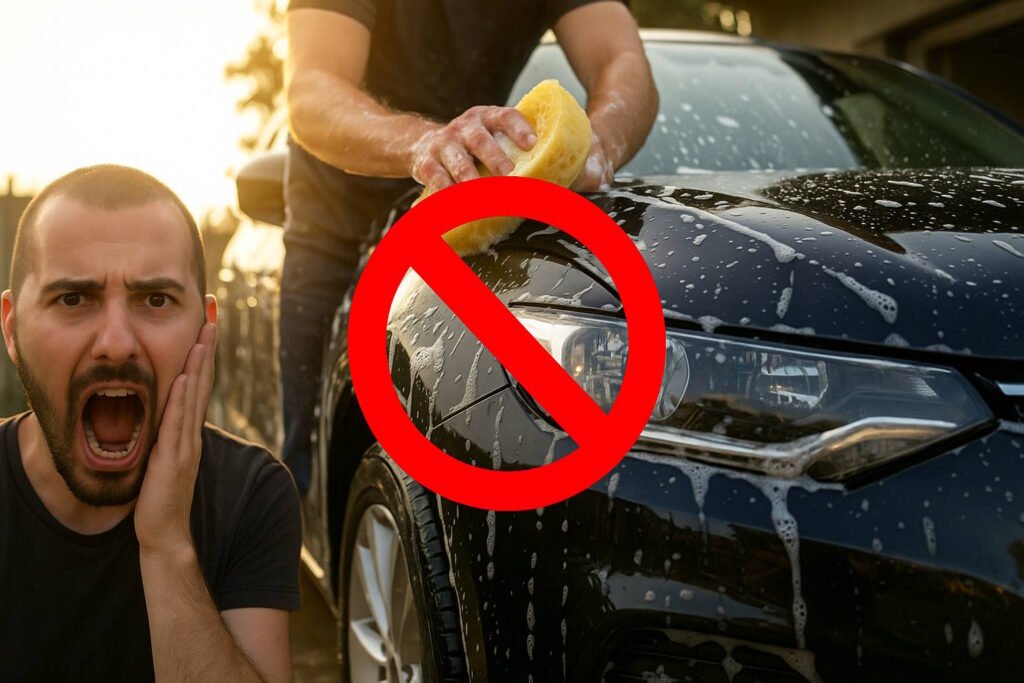You’re staring at your dirty car in the driveway. Water spots cover the windows, dust has settled on every surface, and those bug splatters on the front bumper just won’t budge. You know your car needs washing, but the thought of spending another $15 at the automatic car wash makes your wallet hurt.
I’ve been there too. After 15 years as a professional detailer, I’ve learned that washing your car at home isn’t just about saving money. It’s about giving your vehicle the care it deserves. Let’s tackle everything you need to know about washing your car at home, from the right supplies to the best techniques that won’t damage your paint.
How Often Should You Wash Your Car?
You should wash your car every two weeks under normal conditions. If you live near the coast, drive on salted winter roads, or park under trees, weekly washing is better. For cars stored in garages and driven infrequently, monthly washing is typically sufficient.
The frequency depends on several factors:
Your environment plays a huge role. Cars in coastal areas face salt air that can quickly corrode metal parts. Similarly, vehicles in snowy regions encounter road salt that’s even more damaging.
Your parking situation matters too. Parking under trees exposes your car to sap, bird droppings, and pollen all of which can harm your paint if left unattended. Usage patterns affect washing needs. Daily commuters in urban areas collect more dirt and pollutants than weekend-only drivers.

Can You Wash Your Car Too Much?
No, you can’t wash your car too much if you’re using proper techniques and quality products. However, excessive washing with harsh chemicals or improper tools can damage your paint over time. Quality matters more than quantity when it comes to car washing.
Think of your car’s paint like your skin. Using harsh soaps too frequently strips away natural oils and protection. The same happens with your car’s protective clear coat. The real issue isn’t frequency but technique. Using proper car wash soap, microfiber materials, and correct washing methods means you could safely wash your car daily if needed.
That said, even the best washing techniques involve some minimal friction against the paint surface. Over many years, this can contribute to a microscopically thin clear coat.
Is It Bad to Wash Your Car Every Day?
Daily car washing isn’t harmful if you use proper techniques and products. However, it’s rarely necessary and wastes water and time. Most cars only need washing every 1-2 weeks, even in harsh conditions.
Daily washing becomes excessive for most drivers. Unless you’re driving through mud or construction zones daily, you’re likely wasting water and products. For those with paint protection like ceramic coatings or paint protection film, daily washing might be counterproductive. These coatings work best when allowed to function as designed.
If you feel compelled to clean your car daily, consider using waterless wash products or quick detailers instead of full washes. These products remove light dust without the full washing process.
Data point: According to EPA estimates, a typical home car wash uses 100-140 gallons of water, while washing daily would consume over 36,000 gallons annually, enough to fill a small swimming pool.
How to Wash Your Car at Home
Washing your car at home isn’t complicated, but doing it right requires following a specific process. Here’s my step-by-step guide:
Gather Your Supplies
First, collect everything you’ll need:
- Car wash soap (specifically formulated for automotive use)
- Two buckets (one for soap, one for rinsing)
- Grit guards for both buckets (prevents recontaminating your wash mitt)
- Microfiber wash mitt or sponge
- Wheel brush
- Microfiber drying towels
- Hose with an adjustable nozzle

Data point: Tests show that using the two-bucket method reduces wash-induced scratches by up to 80% compared to the one-bucket method.
Find the Right Location and Time
- Wash your car in a shaded area, not in direct sunlight. Soap dries too quickly in the sun, leaving spots and streaks.
- Morning or evening washing works best. Midday sun can heat your car’s surface to over 140°F, causing water to evaporate instantly.
- Don’t wash your car when it’s freshly driven. Hot surfaces cause soap to dry too quickly before proper rinsing.
Pre-Rinse
- Start by thoroughly rinsing your entire vehicle. This removes loose dirt and debris before touching the paint.
- Work from top to bottom. The lower portions of your car contain the most abrasive dirt, so you want that flowing downward and away.
- Pay special attention to wheel wells, bumpers, and the front grille area where bugs collect.

Two-Bucket Washing Method
Fill your first bucket with water and car wash soap. Fill the second with clean water only. Soak your wash mitt in the soap bucket. Start washing from the top of the car (roof, windows, hood). After washing each section, rinse your mitt in the clean water bucket before dipping back into the soap bucket.
This prevents transferring dirt back onto your car. Work in small sections, rinsing each area thoroughly before moving to the next.
Data point: Laboratory tests show that a single grain of sand dragged across paint can create a scratch visible to the naked eye. The two-bucket method significantly reduces this risk.
Wheels Last
Always wash your wheels last. They’re the dirtiest part of your car and contain brake dust that can damage paint.
Use a dedicated wheel brush that won’t scratch your rims. Different wheel finishes (chrome, painted, alloy) may require different products.
Proper Drying
- Never let your car air dry. Water spots form when minerals in the water remain after evaporation.
- Use quality microfiber drying towels, not regular bath towels or chamois, which can scratch.
- Pat dry rather than wipe when possible. This minimizes the chance of scratching.
- Consider a drying aid spray to make the process faster and safer.
When Is It Too Cold to Wash Your Car?
It’s too cold to wash your car when temperatures are below 32°F (0°C). Washing in freezing temperatures can cause water to freeze in door jambs, locks, and hinges. The ideal minimum temperature for car washing is about 40°F (4°C).
When water freezes in crevices and moving parts, it expands and can cause damage. Modern car wash soaps perform poorly in very cold temperatures, reducing their effectiveness and safety for your paint.
In very cold regions, consider these alternatives:
- Indoor self-service wash bays
- Waterless wash products (for light cleaning only)
- Waiting for a warmer day when temperatures rise above freezing
If you must wash in cold weather, try to park the car in a garage immediately afterward so residual water can dry in a warmer environment.
Data point: Tests show that washing cars in temperatures below freezing can lead to a 70% increase in door seal issues and lock malfunctions.
What Temperature Is Too Cold to Wash Your Car?

Temperatures below 32°F (0°C) are too cold for car washing because water freezes, potentially damaging components. At 40°F (4°C) and above, washing becomes safer but still requires quick drying to prevent issues.
The danger zone starts when temperatures approach freezing. Water trapped in locks, door handles, and window tracks can freeze solid within minutes.
Beyond the freezing risk, extreme cold affects washing in other ways:
- Cold water cleans less effectively because chemical reactions slow down in lower temperatures.
- Your hands will likely be cold and uncomfortable, leading to rushed work and poor results.
- Cars dry much more slowly in cold weather, increasing the risk of water spotting.
- If temperatures are hovering around freezing, check the forecast. If temperatures will rise above 40°F later in the day, wait until then.
Can You Use Dish Soap to Wash Your Car?
No, you should not use dish soap to wash your car. Dish soap strips away protective wax, dries out rubber and plastic components, and can accelerate oxidation of your paint. Always use dedicated car wash soap.
Dish soaps like Dawn are designed to cut through grease on dishes—but they’re too harsh for automotive finishes.
The chemistry tells the story. Dish soaps contain degreasers and surfactants that remove everything from your paint surface, including protective waxes and sealants you’ve applied.
Regular use of dish soap leaves your car’s paint unprotected against UV rays and environmental contaminants.
Data point: Testing shows that a single wash with dish soap can remove up to 85% of the protective wax coating on a vehicle, while proper car wash soap removes less than 10%.
Can You Wash Your Car With Dawn Dish Soap?
No, you should not wash your car with Dawn dish soap. While Dawn effectively removes dirt, it also strips away protective wax and can damage rubber seals and plastic trim over time. Car wash soap is specifically formulated to clean without removing protection.
There’s a persistent myth that Dawn is gentle enough for cars because it’s used to clean wildlife affected by oil spills. This comparison doesn’t hold up.
Dawn is formulated to break down oils and grease. Your car’s paint protection includes oils and waxes that you want to preserve.
The only time Dawn might be appropriate is when you’re planning to completely strip the paint before applying new wax or sealant. Even then, dedicated paint prep products work better.
If you’ve run out of car wash soap, consider these alternatives:
- Baby shampoo (gentler than dish soap, though still not ideal)
- Waterless wash products
- Rinsing with plain water (for very light dust only)
- Waiting until you can purchase proper car wash soap
The Dawn Misconception
Many online sources suggest Dawn is fine for occasional use. The reality is that even a single wash can undo months of paint protection. When professional detailers use Dawn, it’s specifically to strip away all products before applying paint correction or new protection, never as a regular washing solution.
Dish soap doesn’t just affect your paint. It can dry out rubber seals around doors and windows, causing premature aging and potential leaks.
Common Car Washing Mistakes to Avoid

Even with the best intentions, these common mistakes can damage your car:
Using Household Cleaning Products
Never substitute household cleaners for automotive products. Window cleaners, all-purpose cleaners, and dish soaps can all damage automotive finishes.
Automotive surfaces have specific requirements. Products designed for household use aren’t tested for compatibility with clear coats, plastic trim, or rubber seals.
Washing in Direct Sunlight
Direct sun heats your paint, causing water and soap to dry too quickly and leave spots. Hot surfaces can also react differently with cleaning chemicals, sometimes causing staining or etching. Always wash in the shade or on overcast days for best results.
Using Dirty Tools
Reusing dirty wash mitts, sponges, or towels is like washing with sandpaper. Dirt particles get trapped in these tools and then dragged across your paint, causing swirl marks and scratches. Always rinse tools thoroughly during use and wash them properly after each car wash.
Data point: Microscopic examination reveals that a dirty microfiber towel can hold over 200,000 particles of dirt capable of scratching clear coat.
Improper Drying Methods
Air drying leads to water spots as minerals in the water remain on the surface. Old cotton towels or bath towels have fibers that can scratch your paint. Chamois cloths, while traditional, don’t necessarily provide the safest drying method compared to modern microfiber.
Products Worth Investing In
Quality matters when it comes to car care products:
Car Wash Soap
Good car wash soap costs $10-15 but lasts for months. Look for pH-balanced formulas that specify they’re safe for wax. Cheap alternatives often contain harsh detergents that provide a “squeaky clean” feeling by stripping away protection.
Microfiber Wash Mitts
A quality microfiber wash mitt holds more soap, creates less friction, and releases dirt more easily than sponges. Expect to pay $15-20 for a good mitt that will last for years if properly maintained.
Drying Towels
Invest in several plush microfiber drying towels with high GSM (grams per square meter) ratings. Quality drying towels absorb more water, reduce the risk of scratching, and last longer than cheap alternatives.
Final Thoughts
Washing your car at home isn’t just about saving money. It’s about taking proper care of an expensive investment. With the right tools and techniques, you can achieve professional-level results in your own driveway. Your car will not only look better but will maintain its value longer.
Remember, consistency matters more than perfection. Regular washing with proper techniques will always yield better results than occasional “perfect” washes between long periods of neglect. Take pride in maintaining your vehicle. That shine you create isn’t just about looks—it represents protection that keeps your car looking great for years to come.


